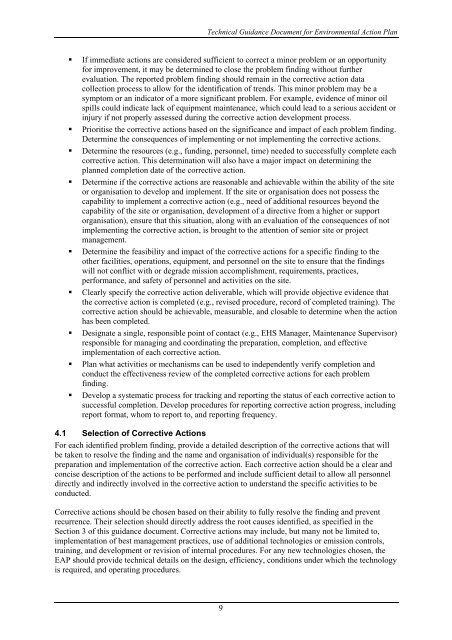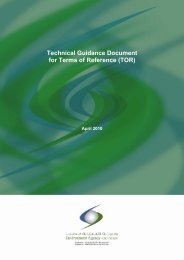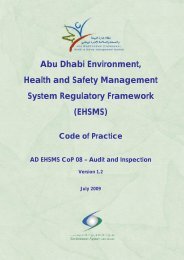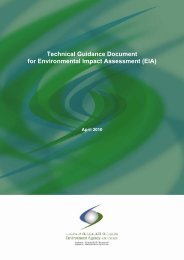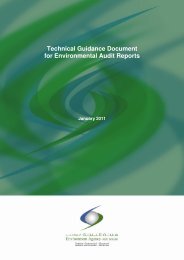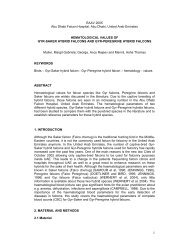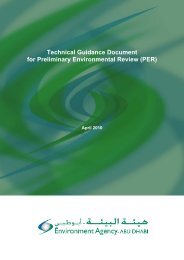Technical Guidance Document for Environmental Action Plan (EAP)
Technical Guidance Document for Environmental Action Plan (EAP)
Technical Guidance Document for Environmental Action Plan (EAP)
Create successful ePaper yourself
Turn your PDF publications into a flip-book with our unique Google optimized e-Paper software.
<strong>Technical</strong> <strong>Guidance</strong> <strong>Document</strong> <strong>for</strong> <strong>Environmental</strong> <strong>Action</strong> <strong>Plan</strong><br />
• If immediate actions are considered sufficient to correct a minor problem or an opportunity<br />
<strong>for</strong> improvement, it may be determined to close the problem finding without further<br />
evaluation. The reported problem finding should remain in the corrective action data<br />
collection process to allow <strong>for</strong> the identification of trends. This minor problem may be a<br />
symptom or an indicator of a more significant problem. For example, evidence of minor oil<br />
spills could indicate lack of equipment maintenance, which could lead to a serious accident or<br />
injury if not properly assessed during the corrective action development process.<br />
• Prioritise the corrective actions based on the significance and impact of each problem finding.<br />
Determine the consequences of implementing or not implementing the corrective actions.<br />
• Determine the resources (e.g., funding, personnel, time) needed to successfully complete each<br />
corrective action. This determination will also have a major impact on determining the<br />
planned completion date of the corrective action.<br />
• Determine if the corrective actions are reasonable and achievable within the ability of the site<br />
or organisation to develop and implement. If the site or organisation does not possess the<br />
capability to implement a corrective action (e.g., need of additional resources beyond the<br />
capability of the site or organisation, development of a directive from a higher or support<br />
organisation), ensure that this situation, along with an evaluation of the consequences of not<br />
implementing the corrective action, is brought to the attention of senior site or project<br />
management.<br />
• Determine the feasibility and impact of the corrective actions <strong>for</strong> a specific finding to the<br />
other facilities, operations, equipment, and personnel on the site to ensure that the findings<br />
will not conflict with or degrade mission accomplishment, requirements, practices,<br />
per<strong>for</strong>mance, and safety of personnel and activities on the site.<br />
• Clearly specify the corrective action deliverable, which will provide objective evidence that<br />
the corrective action is completed (e.g., revised procedure, record of completed training). The<br />
corrective action should be achievable, measurable, and closable to determine when the action<br />
has been completed.<br />
• Designate a single, responsible point of contact (e.g., EHS Manager, Maintenance Supervisor)<br />
responsible <strong>for</strong> managing and coordinating the preparation, completion, and effective<br />
implementation of each corrective action.<br />
• <strong>Plan</strong> what activities or mechanisms can be used to independently verify completion and<br />
conduct the effectiveness review of the completed corrective actions <strong>for</strong> each problem<br />
finding.<br />
• Develop a systematic process <strong>for</strong> tracking and reporting the status of each corrective action to<br />
successful completion. Develop procedures <strong>for</strong> reporting corrective action progress, including<br />
report <strong>for</strong>mat, whom to report to, and reporting frequency.<br />
4.1 Selection of Corrective <strong>Action</strong>s<br />
For each identified problem finding, provide a detailed description of the corrective actions that will<br />
be taken to resolve the finding and the name and organisation of individual(s) responsible <strong>for</strong> the<br />
preparation and implementation of the corrective action. Each corrective action should be a clear and<br />
concise description of the actions to be per<strong>for</strong>med and include sufficient detail to allow all personnel<br />
directly and indirectly involved in the corrective action to understand the specific activities to be<br />
conducted.<br />
Corrective actions should be chosen based on their ability to fully resolve the finding and prevent<br />
recurrence. Their selection should directly address the root causes identified, as specified in the<br />
Section 3 of this guidance document. Corrective actions may include, but many not be limited to,<br />
implementation of best management practices, use of additional technologies or emission controls,<br />
training, and development or revision of internal procedures. For any new technologies chosen, the<br />
<strong>EAP</strong> should provide technical details on the design, efficiency, conditions under which the technology<br />
is required, and operating procedures.<br />
9


